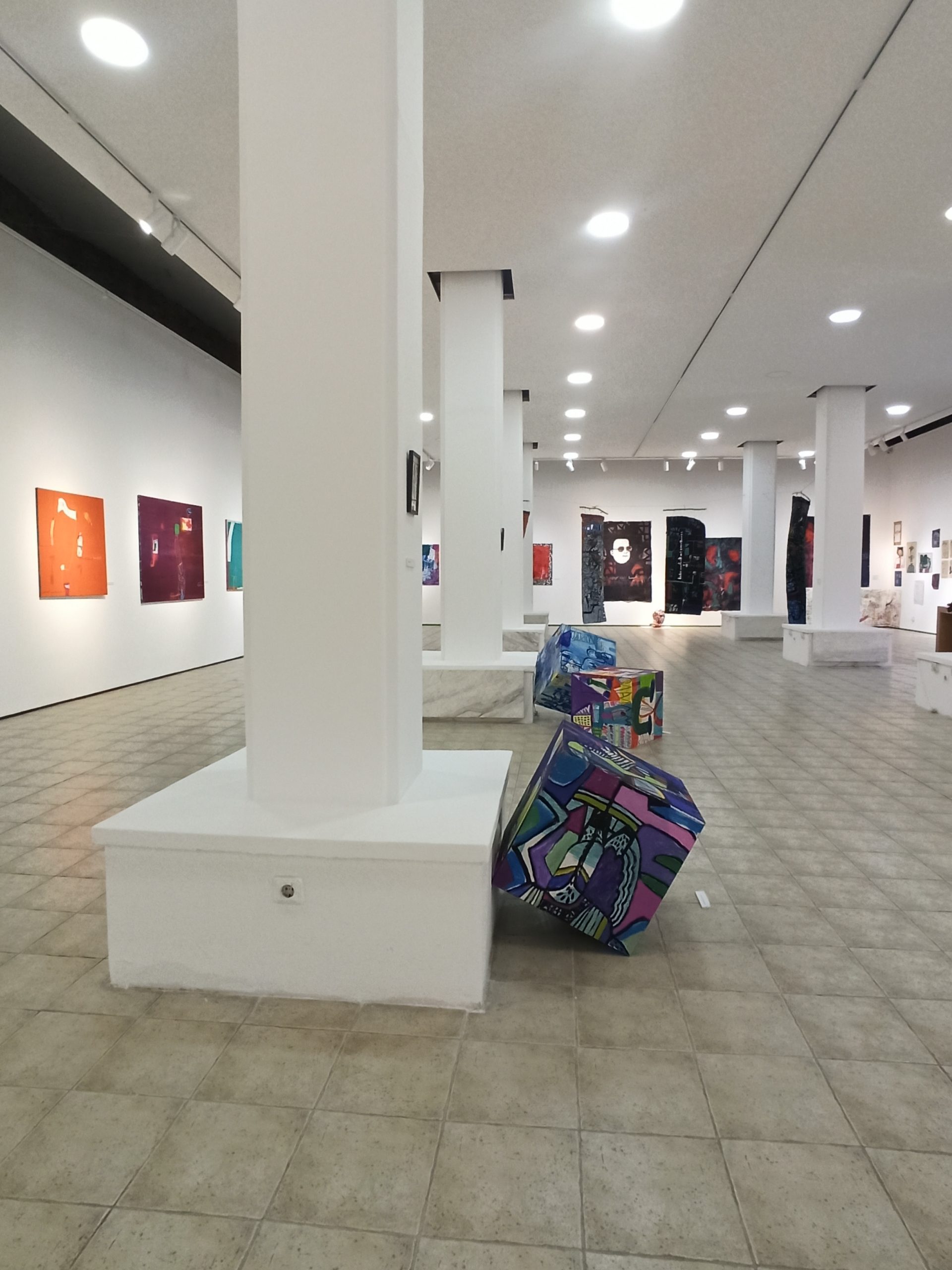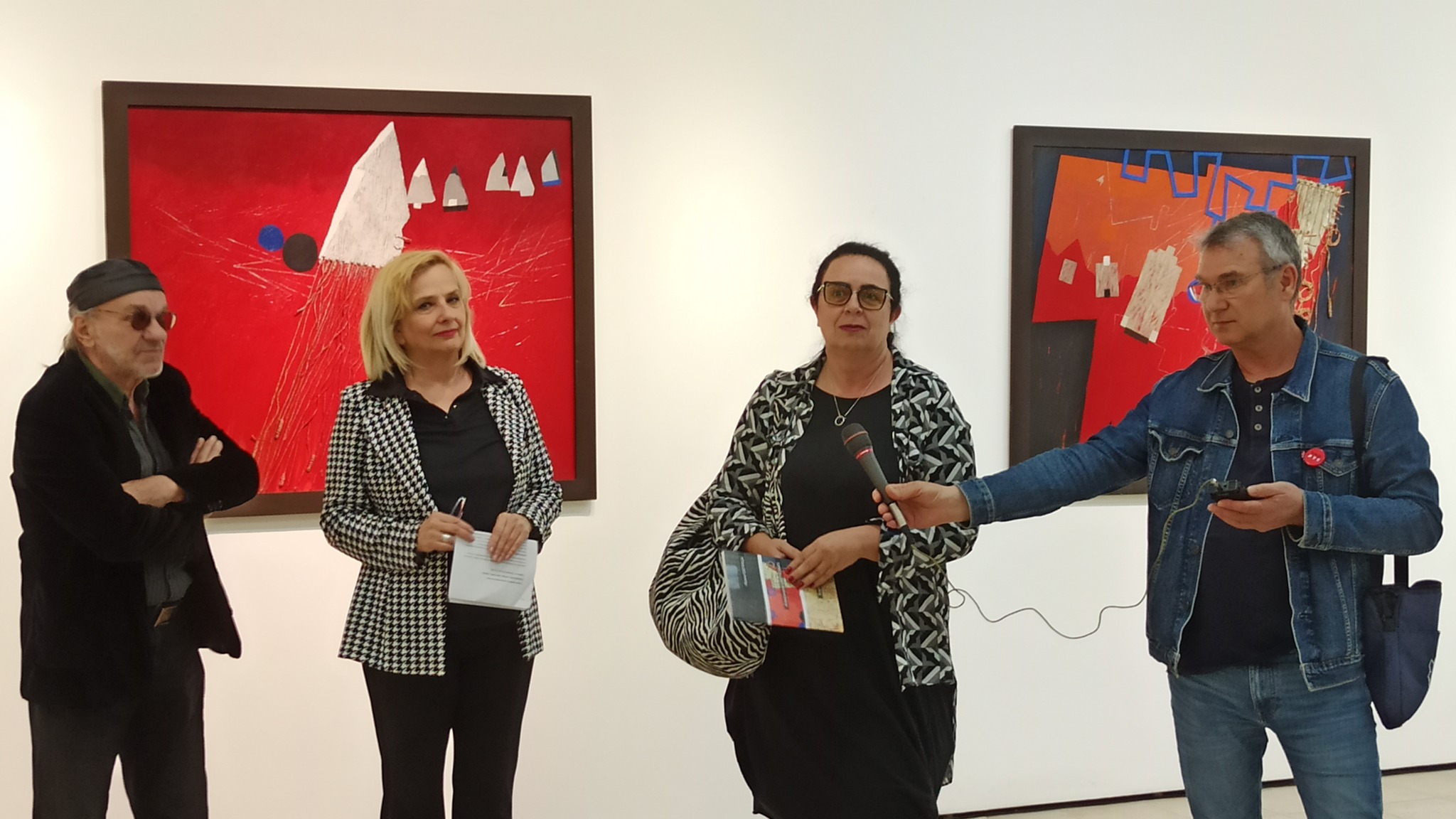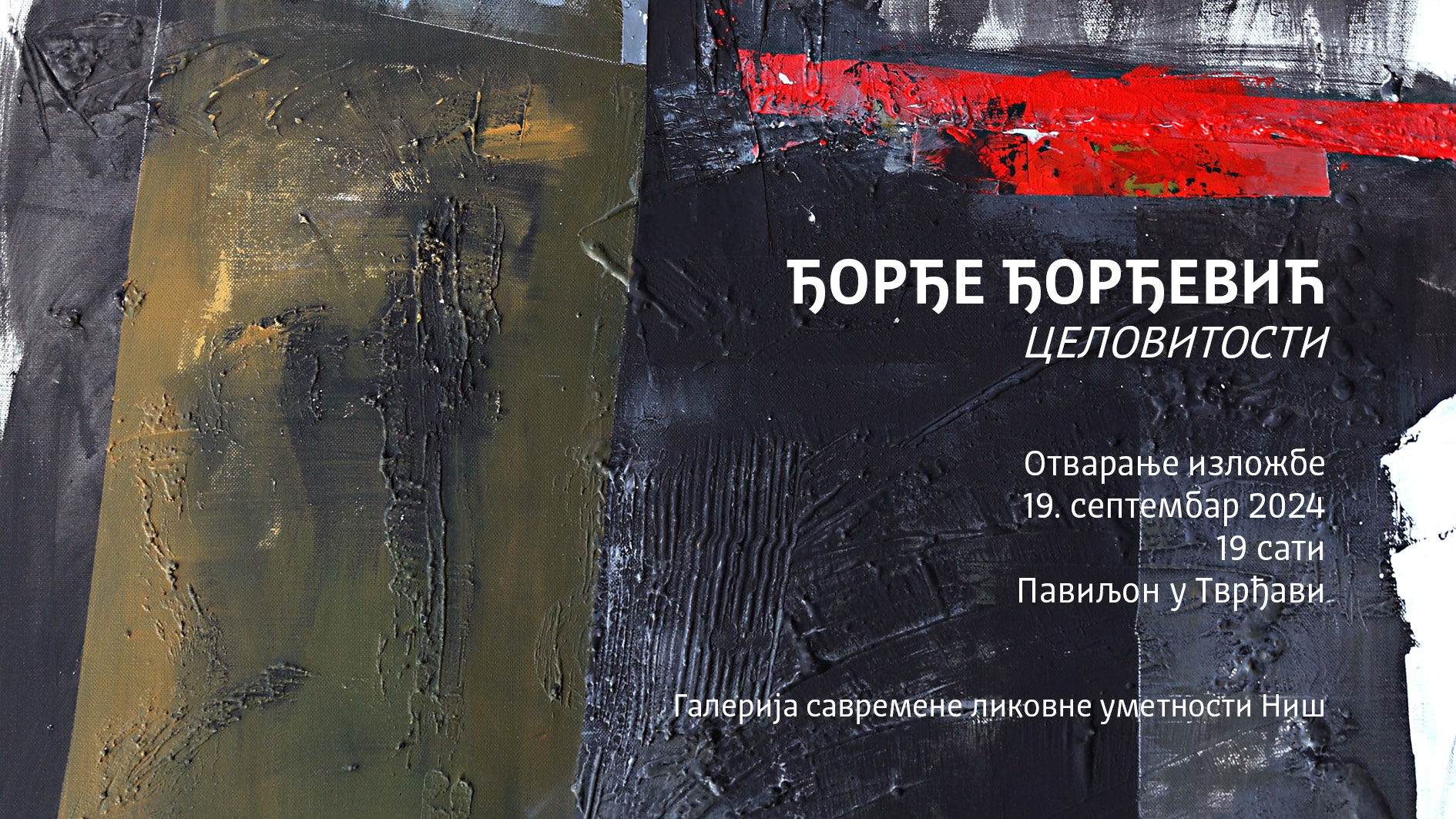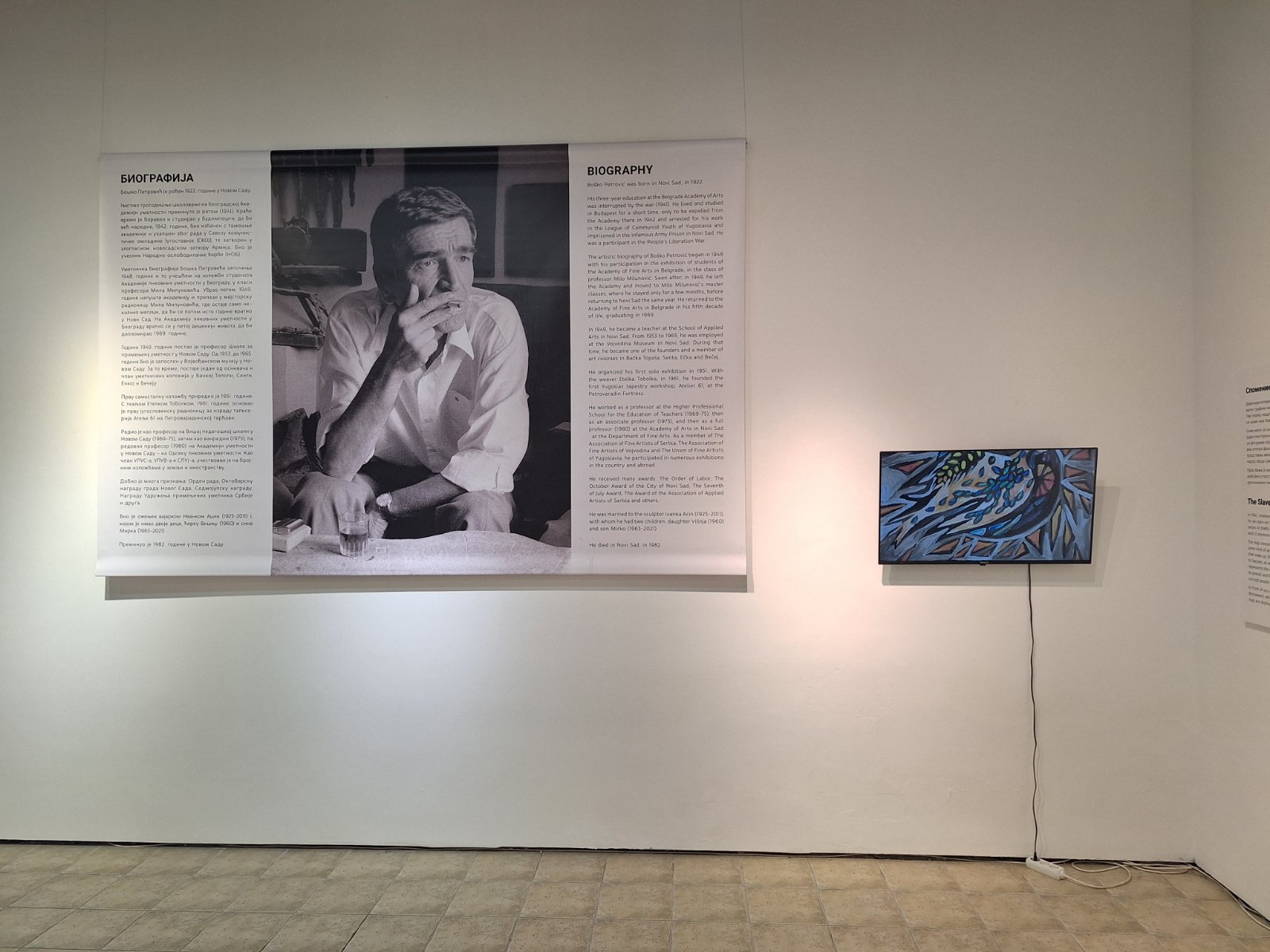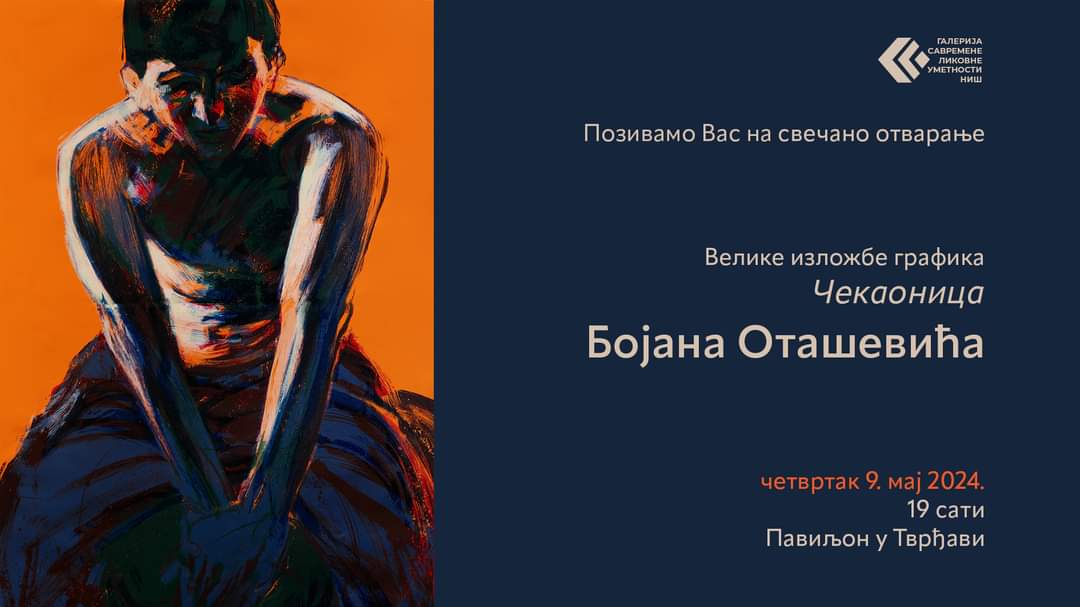ПАВИЉОН У ТВРЂАВИ
Double naked
Joškin Šiljan
Double Nude
paintings and drawings
Fortress Pavilion
Joškin Šiljan is exhibiting at the Gallery of Contemporary Art Niš from June 19 to July 13. The exhibition of his paintings and drawings, entitled "Double Nude", will be officially opened on Thursday at 8 p.m., at the Fortress Pavilion.
The exhibition in Niš includes works from several different cycles, and the title is due to the most recent one.
“Through his creative work, Joškin Šiljan creates new worlds, while simultaneously expressing the philosophical nature of his thoughts. His painting constantly explores pure art, which expresses freedom and spontaneity both through the iconography itself and authentic visual language, as well as through reflections and the artist’s understanding of the world, which is as such light and simple, unburdeningly fresh.”, observes art historian Ana Kršljanin, curator of the ŠTAB gallery. She sensitively concludes that the artist “swims in the limitlessness of themes, movements and beings that, with witty and long titles, give the viewer an impulse that he needs to feel and convey, allowing him to be the one who completes the picture and the story.”.
Joškin Šiljan (Nebojša Stojković, 1953, Pirot) belongs to the generation of artists who emerged on the art scene in the 1990s. He is one of the most famous and active authors on the regional art scene, and his exhibitions in world museums and galleries make him internationally visible and recognized. He is a participant in a large number of art colonies and residency programs in the country and abroad. His works are in significant museum, company and private collections around the world. He has won several significant awards, including: the Golden Palette of ULUS (2006), the Grand Prize at the 14th Biennial of Naive and Marginal Art (2009), the Main Prize for Painting on Paper OSTEN (2016), and the Golden OSTEN for Drawing (2018).
He lives and works in Grdelica.
The exhibition of his works can be visited by the public until July 13, in the Paviljpn in Tvrđava.
GRAPHIC WORKSHOP ''SIĆEVO 2022-2024''
EXHIBITION OF GRAPHICS CREATED IN THE GRAPHIC WORKSHOP IN SIĆEVO 2022-2024, PAVILION IN THE FORTRESS
May 27 - June 22, 2025
For several years now, the Gallery of Contemporary Fine Arts Niš, as a highly professional institution in Serbia, has been organizing the Graphic Workshop in the beautiful village of Sićevo near Niš.
Initiatives to equip the graphic workshop began in 2003 at the suggestion of Slobodan Radojković, then a master of graphics employed at the Gallery. One of the rooms within the building of the Art Colony "Sićevo" was converted into a graphic workshop, when a gravure printing press was purchased.
In 2005, the Gallery of Contemporary Art celebrated the centenary of the first gathering of artists in the Art Colony in Sićevo. Soon after, all the basic funds and necessary materials for work were secured, thus creating the conditions for the first gathering of four artists in September 2006. There are multiple reasons why the Gallery decided to establish a graphic workshop. First of all, it was noted that there were only two workshops of a similar nature in Serbia: in Smederevo (Graphic Studio of the Cultural Center) and Belgrade (Centre for Graphics and Visual Research "Academy"). The Centre for Graphics and Visual Research "Academy" at the Faculty of Fine Arts in Belgrade organizes a graphic workshop whose work is focused on the preservation and popularization of graphics, as well as monitoring the development of the medium itself. It was a role model, or one could say a model, for the creation of the Sićevo workshop. Also, in Niš there is an active association of artists "Niš Graphic Circle", which contributed and gave full support to the initiative itself. One of the important reasons is certainly the awareness that the workshop will constantly contribute to the addition of the collection of graphics within the fund of the Gallery of Contemporary Fine Arts. It has been noticed that an increasing number of artists are committed to this medium, and that in addition to old graphic techniques they apply new, computer technologies, and that their understanding of graphics as a medium is much more flexible and modern.
Therefore, through the work program, the Graphic Workshop is focused, first of all, on the preservation of graphic art, but also on monitoring new tendencies of graphic print today. By popularizing this widely represented medium, the Gallery has already traditionally gathered significant names from the international artistic scene, but also follows the maturation of young authors from the graphic world. For the first three years, the Workshop was held twice a year (spring-autumn) for seven days, and since 2011 only at the end of spring.
The Graphic Workshop "Sićevo" gained an international character in 2008. So far, 90 artists from Niš, Serbia, Montenegro, Macedonia, Bulgaria, Greece, Poland, Italy, Belgium, Denmark, USA, Mexico, Canada, Italy have created and left their works for the collection of the Gallery of Contemporary Fine Arts in the Graphic Workshop.
According to the workshop's statute and propositions, each participant of the Workshop leaves two gallery-format graphics in a circulation of five prints to the Gallery of Contemporary Fine Arts, and in return, the Gallery provides the artists with all the basic means for work, as well as accommodation, food and travel expenses. In addition to working on matrices, printing graphics in the studio, exchanging experiences, and demonstrating certain techniques, excursions were also organized so that participants could get to know the surroundings and sights of Niš better. A tour of the Sićevo Gorge, a large number of monasteries located in the immediate vicinity, as well as other cultural and historical buildings of Niš from different periods, certainly completes the artists' picture of the rich past of our city.
The collection of the Graphic Workshop now includes about 200 graphic sheets. Each of the artists who participated in the work of the Graphic Workshop "Sićevo" created graphics in the spirit of their already formed artistic expression. The variety of graphic techniques is another segment of the rich palette of graphic sheets from the Gallery's collection. Many of them were influenced by the natural beauty of the Sićevo Gorge itself, so they permanently recorded their impressions of the environment through their works (Biljana Vuković, Snezana Marinković, Vladimir Vlajić, Marta Božik, Branko Nikolov, Ivana Stanković, Zoran Kostić, Michel Barzen, Bojan Živić), others found inspiration in some details of the surroundings (Velizar Krstić, Jelena Sredanović, Ljubiša Brković, Magda Krolikovska, April Wilmer, Roberto Gianinetti, Ranka Lučić Janković, Veliko Maričevski, Marija Sibinović).
Works from the graphic workshop "Sićevo" were exhibited in Niš, Prokuplje, Leskovac, Valjevo, Pirot, Sofia, Kotor, Dimitrovgrad. The good reputation of the Graphic Workshop "Sićevo" is getting louder every year and we believe in the future of this event. The support of the cultural public, colleagues, and the Ministry of Culture of the Republic of Serbia give us hope that we are on the right track.
We must add that in 2020, a screen printing press with all the accompanying elements was provided in order to expand the activities of the colony participants and enable work in other graphic disciplines. With the purchase of a new press, the studio and graphic workshop premises were further renovated with an expanded and adapted space in the building of the art colony in Sićevo, so that decent conditions were created for work on both presses.
https://www.youtube.com/watch?v=HKzmFPltaUw
EXHIBITION OF PAINTINGS: BJELICA, CVETKOVIĆ, KOVAČEV
Gallery of Contemporary Fine Arts Niš
PAINTINGS EXHIBITION: BJELICA, CVETKOVIC, KOVAČEV
PAVILLION IN THE FORTRESS (April 29 - May 23)
A joint exhibition of three artists with different approaches, ideas and concepts is an opportunity for the art public to become more familiar with the diverse trends of our contemporary art.
IVANA BJELICA (Novi Sad, 1969) graduated from the Academy of Arts in Novi Sad, Department of Painting, in the class of Professor Milan Blanuša. She has held over twenty solo exhibitions and has exhibited at over a hundred collective exhibitions in the country and abroad (Serbia, Montenegro, Croatia, Macedonia, Greece, Romania, Spain, Great Britain, France, the Netherlands, Turkey, Argentina, Mexico, Canada, Japan, India).
She has won several awards in the field of fine arts (drawing, painting, collage).
She is a member of SULUV, ULUPUDS and the Art Circle (Association of Artists of the Petrovaradin Fortress). She has participated in numerous art colonies, art expos and other art events. Her works of art are in numerous private, gallery and museum collections in Serbia and abroad. In addition to fine arts, she is involved in photography, graphic design and interior design. For many years, she was the editor of the art program of the Mali likovni salon gallery, Cultural Center of Novi Sad (2003-2007), she has realized a significant number of exhibitions of eminent artists from the country and abroad and has achieved successful cooperation with many cultural institutions.
He is the founder of the Lumens art association (2013), whose main goal is the development and promotion of contemporary fine arts and culture, international cooperation and education.
He is known to the Niš audience as a participant in the Sićevo Art Colony in 1978, 1994, 2019. The gallery in the Fund contains 6 works. He had a solo exhibition in 1982, and participated in the Niš Salon 2020.
He lives and creates as an independent artist in Novi Sad.
With a careful formulation of the plastic-poetic and aesthetic, he builds concise artistic wholes. At the center of her artistic research is nature or man in the environment in which we live, understanding the complex human destiny. The dynamic gesture and light-dark contrasts are not in the function of any drama, but rather serve to more clearly define space or ideas.
ALEKSANDAR CVETKOVIĆ (Aleksinac, 1947) graduated in painting from the Academy of Fine Arts in Belgrade in 1973, where he also completed his postgraduate studies in 1975. In five decades of creative work, he has organized nearly eighty solo exhibitions in the country and abroad, and participated in the selections of several hundred art events on almost all continents.
He has won a number of domestic and international awards and recognitions, including: Awards for painting at the October Salon in Belgrade in 1977 and 1988; Award at the International Drawing Exhibition in Nuremberg in 1979; First Prize at the YAVA Biennial in New York in 1980; Award at the Alexandria Biennial of Art in 1980; Golden Palette of ULUS in Belgrade in 1985; Politika Award in Belgrade in 1990; Awards at the Nadežda Petrović Memorial in Čačak in 1978 and 1990; Award for Painting at the Milena Pavlović Barila Memorial in Požarevac in 1985 and 1995; Award of the City of Belgrade Despot Stefan Lazarević for 2021, Recognition for Outstanding Contribution to National Culture in 2024. His works are in numerous museum and private collections in the country and abroad.
He is a member of ULUS. He lives and works in Belgrade.
Cvetković follows his own feelings and the sensibility of society in a special way with a deconstructed visual language. Having traveled a long way from hyperrealism through new expressionism, informel and pop art to liberal modernism, he continues to explore mythological and historical themes. In the process of forming new, metaphorical wholes, he introduces new materials, while simultaneously nurturing his own pictorial system, achieving highly aesthetic visual art.
ĐORĐE KOVAČEV (1947) graduated from the painting department of the Academy of Fine Arts in Belgrade in 1972. In addition to painting, he is also involved in musical creativity in various genres. He lived and exhibited in Vienna, Austria from 1982 to 1986. He has had several solo and collective exhibitions. Currently, his permanent exhibition is in the “Kovačev” gallery in Čurug.
While still a student at the Academy of Fine Arts, working in a conservation team at the archaeological site of Lepenski Vir, he came into contact with objects and artifacts created by a man, a member of the Lepen culture. His interest in archaeology dates back to that time, and he deepened it even more during the period when, as a museum associate, he made drawings for documentation at the sites of Velesnica, Gomolava, etc.
In the meantime, he studied various anthropological studies on Amazonian tribes such as the Yanomame. He was particularly interested in the study of Aborigines conducted by Geza Rahaim in the 1930s.
As a result of all these experiences, a cycle of paintings, totems, sculptures, and objects was created, which he himself titled: From Churug to Churunga (Churunga is a well-preserved relic of great importance for the identity of Aboriginal tribes).
He lives and works as an independent artist in Churug.
Kovachev has a clearly defined concept in which he intertwines
PLURAL STRATEGIES
EXHIBITION "PLURAL STRATEGIES" - SELECTION FROM THE COLLECTION OF CONTEMPORARY PAINTING OF THE GALLERY OF CONTEMPORARY FINE ART IN NIŠ
Pavilion and Fortress /December 12th at 1:00 PM/
After exhibitions in Novi Sad and Belgrade, the Gallery of Contemporary Fine Arts Niš is organizing an exhibition from its rich collection entitled "Plural Strategies".
The exhibition features 30 Serbian artists from the second half of the 20th century who, as leading figures of their time, left a deep mark on our art history: Mladen Srbinović, Stojan Ćelić, Mića Popović, Milan Konjović, Ivan Tabaković, Zoran Pavlović, Boža Ilić, Lazar Vujaklija, Ljubica Cuca Sokić, Bora Iljovski, Peđa Milosavljević, Olja Ivanjicki, Sinisa Vuković, Mihajlo Petrov, Stojan Trumić, Bojan Bem, Čedomir Krstić, Boško Petrović, Kosa Bokšan ...
During the seventh and eighth decades, in addition to the existence of a number of newly formed individual painting practices, several parallel currents were discernible, so that completely separate artistic languages and innovative artistic phenomena began to exist at the same time.
Different artistic practices in one artist's work lead to the dematerialization of the work of art, penetrating the essence of the visual language. At the same time, new cultural and artistic phenomena begin to deal with existential questions, that is, critical reexaminations of reality. In addition, during that period, a group of artists appears on the Serbian art scene, expressing interest in the renewal of the figure in different contexts.
The selected works of art do not have a connection with the themes or ideas they explore, but as diverse visual achievements with completely individual problem concepts, they represent significant material for researching the development of visual art in these areas. Artists of various stylistic orientations, as representatives of complex artistic developments, participated in the formation of the collection of the Gallery of Contemporary Fine Arts, which today is among the most valuable collections in our country, aspiring to soon grow into the Museum of Southeast Serbia.
https://youtu.be/JPx8n8U4QUg?si=w2UqtvBpg59KJ-WN
LIDIJA UZELAC'S EXHIBITION: "WHERE I AM"
LIDIJA UZELAC EXHIBITION: "WHERE I AM"
PAVILION IN THE FORTRESS 24 October - 10 November
As a curious artist who always strives for new, exploratory processes, Lidija Uzelac uses various visual techniques: paintings, drawings, canvas printing, layered collage fitting, installations, creating a fresh, innovative system.
Problematizing different ways of reading through enigmatic structures of action, in one part of her latest project she forms free, geometrized forms emphasizing the power of color and lines that possess a wide range of meanings, while in the other part she records her intimate states through a portrait of a Renaissance woman as a personification of mother, woman or matrix, alluding to the source and meaning of existence. Defining the flow of her own thoughts, memories and emotions, she skillfully combines materials to form narratives that relate to the phenomenon and essence of being.
Different levels of meaning invite deeper reflection on the relationship between image and space, reality and illusion, emphasizing elements of property in the current moment.
By arranging very carefully clean, systematically shaped geometrized surfaces and lines through a focused, intimate approach, she forms a complex visual language that functions in the coordinate system of personal symbolism.
Observing the painting process as a mechanism for reading the complex human nature, she expresses a clear personal stance, opposing the increasingly present loss of individual identity. In the title of the exhibition “WHERE I AM”, the artist seeks to establish contact with the viewer by drawing attention to the paradoxes of the contemporary social moment. In addition to abstract paintings and drawings, an independent entity is represented by a wall installation called: "Alma Mater", expressing her fascination with the portraits of women of the Renaissance masters, which remained recorded in her memory since the time of her studies in Florence, as an intriguing motif that for her represents a striking level of meaning related to nature, life, love, truth, wisdom, revealing the deeper truths of human existence.
Expressing a penchant for reduced forms, an analytical, layered approach and thoughtful compositional construction, Lidija Uzelac forms her own positions in the complex perception of the world and art.
Lidija Uzelac (1961. Travnik), graduated from the Academy of Fine Arts in Florence, Department of Painting, and then specialized at the Academy of Arts "Brera" in Milan. She completed her master's degree in the class of prof. Radomir Knežević at the Faculty of Arts in Banja Luka. She has organized 24 solo exhibitions in Pančevo, Pirot, Raška, Plovdiv, Smedrevska Palanka, Niš, Belgrade and over 50 group exhibitions in Serbia and abroad. She teaches at the Faculty of Arts in Niš as a full professor at the Department of Graphic Design in the subject of drawing and painting.
The exhibition will run until November 10.
Djordje Djordjevic "Integrity"
Đorđe Đorđević "Integrity"
September 19 – October 14, 2024
After a long time, the artist Đorđe Đorđević will present himself to the public in Niš with an exhibition of paintings, entitled "Integrity". The exhibition consists of works from his current artistic production, including a number of this year's paintings. The exhibition will open on Thursday, September 19 at 7 p.m. in the Pavilion in Tvrđava.
Starting from the mid-1980s, Đorđe Đorđević's abstract painting opus has developed consistently, recording subtle shifts in terms of reducing the palette and repertoire of graphic symbols. Emphasizing the mental and emotional-expressive qualities of Đorđević’s creative personality, art historian Jovan Despotović notes his ability to disregard rules: “It allows him to maintain the pictorial scene in a consistent state in a justified compositional order, despite the risky process of crossing mutually exclusive principles of geometricism and gesturality in the same pictorial field…”.
With his recent painting, Đorđević offers resistance to the deafening hustle and bustle of everyday life. The basic element and unit of these compositions is the quadrangle, which embodies stability and harmony, but also neutrality and subordination to a larger whole. The gesturally treated surfaces, in comparison with the smaller monochrome fields, reflect the artistic principle of the unity of elements and the dominant, and this is also the thesis that the author examines on a semantic level. Therefore, transferred to the field of social relations, it is the principle of collective interests, which implies the discreet correction of the individual desires of the participants, the conscious surrender of part of personal dignity for the sake of the integrity of the community. In his autopoetic text, Đorđe Đorđević emphasizes that catholicity is an acute social need of the time in which we live.
Đorđe Đorđević was born in 1949 in Belgrade. He graduated from the Accademia di Belle Arti di Brera in Milan, Italy, in 1972. From 1974 to 1976, he designed textiles for the leather and textile factory "Viteks" in Visoko, near Sarajevo. He held twenty-five solo exhibitions in Serbia, Italy, Croatia, France, Montenegro and Austria and took part in a large number of collective exhibitions. His works are represented in several public and private art collections. He has been a member of ULUS since 1981, and in 1982 he received the status of an independent artist. He lives and works in Belgrade.
https://www.youtube.com/watch?v=zNAAxyzg2mc
"Trepča" by Ljiljana Šunjevarić
Trepča by Ljiljana Šunjevarić.
Ljiljana Šunjevarić's latest artistic ensemble will be exhibited for the first time in Niš, at the Pavilion in Tvrđava from August 22 to September 15. With these paintings, the artist remains consistent with issues of social reality, but makes perhaps the first more extensive contribution to understanding the living conditions in northern Kosovo in domestic art. The Trepča Mining Complex, which symbolizes the betrayed ideas of socialist workers' progress, indirectly tells us about the policy of restoring Serbia's sovereignty over the province, from the late 1980s and the more than excessive epilogue from the 1990s. However, Ljiljana's paintings mostly thematize the twenty-year transitional vacuum in this territory, the issues of people's lives and endless expectations. Therefore, the artist paints vedutes of this complex in a hilly landscape, genre scenes from the Trepča restaurant, and portraits of the staff and its guests in muted tones. With the Trepča exhibition, Ljiljana Šunjevarić makes precise but open artistic observations and thus provokes a response from the public consciousness.
Ljiljana Šunjevarić was born in 1979 in Užice. She graduated, received her master's and doctorate in painting from the Faculty of Fine Arts, University of Arts in Belgrade. She has been actively exhibiting at solo and group exhibitions in the country and abroad since 2000. She has been awarded in the field of drawing. She is the author of several art projects in public space. She has participated in numerous domestic and international art colonies and workshops. Her works of art are represented in many collections: Collection of Paintings / Period after 1950 of the Museum of Contemporary Art in Belgrade; Collection of Contemporary Art of the Nadežda Petrović Gallery in Čačak; Collection of the Gallery of Contemporary Art in Zrenjanin; Collection of the National Museum in Arandjelovac; Collection of the National Museum in Smederevo; Collection of the City Museum of Belgrade; Collection of the National Museum in Kraljevo; Collection of Contemporary Painting of the Gallery of Contemporary Fine Arts in Niš and in several private collections. She is employed at the Faculty of Arts of the University of Pristina with a temporary seat in Kosovska Mitrovica, with the title of Associate Professor.
Exhibition Boško Petrović: Sketches for Great Works
Exhibition Boško Petrović: Sketches for Great Works, Pavilion in the Fortress
The Gallery of Contemporary Fine Arts Niš invites you to the grand opening of the exhibition Boško Petrović: Sketches for Great Works on Thursday, July 11 at 8 p.m., Pavilion in the Niš Fortress.
An extensive opus of drawings for tapestries, sculptures, and mosaics will be presented to the Niš audience thanks to the cooperation of the SLU Gallery and the Museum of Vojvodina, which owns a large number of works by Boško Petrović, on the occasion of an important anniversary - the hundredth anniversary of his birth and forty years since the death of the famous artist.
Boško Petrović belonged to the war and post-war generation of authors who, in the middle of the last century, set out in search of a new, authentic artistic expression. In addition to classical painting, he worked with mosaics, drawings, watercolors, collages, and graphics, and is one of the rare artists who contributed to the development of tapestry and its affirmation.
In order to present the part of the works that presents the creative process and method of work, without emphasizing the subject itself, the author Dragana Garić Jovičić presents the sketches for a monument, a mosaic, and a tapestry in the exhibition Sketches for Great Works. All three works, created in different techniques, were conceived as monumental, but the sculpture was never realized.
The audience will have the opportunity to see for the first time a model of the monument and a map of graphics for the Monument to Slavery, created during World War II, partly as a result of novice artistic searches but at the same time one of the first ideas for a monument to the revolution that emerged in occupied Europe.
In the early 1950s, Boško Petrović began to work intensively with mosaics, primarily small-format portraits in this technique, and part of the exhibition is one of the more impressive sketches for the monumental mosaic that is today in the Assembly of the Autonomous Province of Vojvodina.
A special set of works are sketches on the theme of revolution, made for tapestries and murals, created in the period from 1965-75. The extensive cycle of sketches, together with the monumental tapestry, depicts the dedication and professionalism with which Boško Petrović approached the topic.
According to Dragana Garić, the original, bold and expressive artistic expression of this artist with an exceptionally rich oeuvre has placed him among the most significant Vojvodina artists.
Boško Petrović was a participant in the Sićevo Art Colony in 1975, he organized a solo exhibition in Niš in 1976, and the SLU Gallery has 16 of his works in its collection.
The exhibition in the Tvrđava Pavilion will be open to the public until August 5.
https://youtu.be/1RdpY3jXDWg?si=G-xbmEWe9uFO00XB
Бојан Оташевић
У четвртак 9. маја, у Павиљону у Тврђави је отварна самостална изложба др Бојана Оташевића, редовног професора Филолошко-уметничког факултета у Крагујевцу. Изложбу чине графике великог формата из циклуса „Чекаоница“, настале у последњих десетак година а реализоване у техници алграфије са више бојених пролаза.
Бојан Оташевић више од двадесет година развија аутентичан опус који је компактан у својој јединствености и доследности. Од самих почетака определио се за свет фигурације, односно за традиционалан жанровски репертоар који доминантно почива на портретима и људским фигурама. Међутим, мотиве који стоје у основи ликовног изражавања од праискона, Оташевић користи као средство говора о актуелном друштвеном тренутку. Његове усамљене фигуре спуштених рамена и скрајнутог погледа , најчешће актови, су симбиоза стања отуђења и збуњености савременог човека затеченог у лавиринту постојећих збивања, која су таква да неминовно узрокују егзистенцијалну и емотивну забринутост над властитом судбином. Уметник фигуре представља у гро плану, често у седећем ставу, без покрета, али се иза те физичке статичност крије еруптивна унутрашња енергија, ковитлац мисли и осећања, што Оташевић постиже вештом комбинаториком ликовних елемената базираних на силини геста, односу светло-тамно и контарсном а раскошном колористичком спектру. Називајући свој најновији циклус графика „Чекаоница“ од безимених појединачних портрета и фигура Оташевић ствара неку врсту групног портрета људи са друштвених маргина који ишчекују нека боља времена а потенцијални су носиоци нужних промена.
Бојан Оташевић је рођен у Крагујевцу 1973. године. Дипломирао је, магистрирао и докторирао на Факултету ликовних уметности у Београду. Приредио је педесет самосталних изложби у многим градовима Србије и у Канади, Литванији, Босни и Херцеговини и Црној Гори. Добитник је 23 награде међу којима су значајна национална признања за графику: награда Златна игла УЛУС-а (2002), Мали печат (2015) и Велики печат Графичког колектива (2018) као и награде на међународним манифестацијама: Бронзана игла на 12. Интернационалном бијеналу „Сува игла“ у Ужицу, Велика диплома на 12. Међународном бијеналу портрета у Тузли и Специјално признање за допринос графици у свету на Тријеналу графике у Битољу.
Изложба ће трајати до 26. маја
https://youtu.be/SI6fxkRunJ4?si=-F7f23aJOpgsCya7
ГРАФИКА И ЦРТЕЖ
систематичан начин презентују активности студената, драгоцен су извор информација. Пред нама је избор радова који износи реално стање актуелне уметничке студентске продукције. Он указује на ентузијазам младих стваралаца, на њихову динамичност, богатство идеја и на суштинску условљеност графике и цртежа у приказаним делима.



